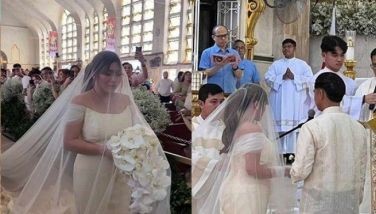A sanctuary of faith
MANILA, Philippines - Cebu City is one of the country’s most progressive urban centers, but even the busiest cities have little corners of serenity. One such patch of tranquility is just around a 30-minute drive away: Tabor Hill, which sits on a five-hectare property in Brgy. San Jose.
Founded 18 years ago, Tabor Hill is the site of the provincial house of the Order of Discalced Augustinians in the Philippines, home of OAD aspirants and brothers. For a place that’s so peaceful, it’s a hive of activity. Tabor Hill College-OAD offers bachelor’s degrees in philosophy, music and religious education. A retreat facility that can accommodate some 180 people is open for public use. Tabor Hills’ workers and their families also live there, and they tend to the piggery, poultry farm and vegetable garden that benefit the entire community.
For those who want to spend their time in prayer, they can have their pick of quiet spots: The Adoration Chapel, the Ecce Homo or Holy Stairs, the grottos of Our Lady of Consolation and Our Lady of Lourdes, as well as the oratories of St. Rita and Our Lady of Manaoag. There are also spaces that serve as moving testaments of the Catholic faith, such as the Fatima Garden with its tableau of the three child-visionaries of Fatima — Lucia, Jacinto, Francesco — and the Stations of the Cross with its life-sized statues.
But perhaps in all of Tabor Hill, it’s the Chapel of Holy Relics that intrigues the curious and the contemplative, the humble and the hopeful. No surprise there: The chapel shelters over 600 relics, according to its curator, Fr. Dennis Duene Gutierrez Ruiz, OAD. The 34-year-old chaplain, who was born in Nasipit, Agusan del Norte, earned a graduate degree in the cultural heritage and history of the Church from the Gregorian Pontifical University in Rome. Fr. Ruiz is currently the procurator, profess master and national coordinator of OAD lay associates.
It all began in 2002, when a cloistered nun gave Fr. Ruiz first-class relics of St. Augustine and his mother St. Monica. These gifts were specifically for a convent in the Philippines where the two saints are the spiritual founders. This inspired the young priest to learn more about the lives of saints and martyrs. And soon enough, he started requesting relics of Augustinian saints.
Because his nearly eight-year stay in Rome included a stint working at the Office of the Relics in the Vicariate of Rome, Fr. Ruiz was able to collect more relics, which are not — and should not — be sold because they shouldn’t be tainted by commerce.
But of course, obtaining these valuable items isn’t easy at all. A strict procedure and specific hierarchy should be followed. All requests must be endorsed by either a bishop of a diocese, or the superior/provincial father-general of a major congregation. The letter must also specify that the relic will be used for public religious purposes, such as a church altar. People who profit from trading in relics are guilty of simony, according to Church teachings.
All of the chapel’s relics have authentic, numbered documents from the Vatican, says Fr. Ruiz. Based on the system devised by the Catholic Church, first-class relics are a body part of a saint — perhaps strands of hair, fragments of bone, bits of skin or dried blood. Second-class relics are items used by a saint during his or her lifetime, while those deemed third class are objects that have touched a first-class relic. Fourth-class relics are objects that have come into contact with a second-class relic.
The relics are kept in individual containers called reliquaries, which are specifically made to store and display these holy objects. Fr. Ruiz explains that the chapel’s reliquaries, which are from 20 to 32 inches in height, were crafted by the finest Cebuano talents. Inspired by baroque design, each reliquary has gold-leaf gilding and symbols based on which grouping the saints belong to, which includes kings and queens, hermits and monks, virgins and martyrs, doctors of the church, founders of congregations, popes and bishops, among others.
Above the chapel’s main altar is a striking painting that depicts the Holy Trinity. The central figure is Christ, and it showcases soil from Mt. Tabor, Israel — the exact location where the Transfiguration took place.
A little below the painting are four important images with corresponding relics. The Blessed Virgin Mary and St. Joseph are represented by artifacts from significant abodes: A marble slab of the house where her Assumption took place and a piece of the family dwelling in Nazareth, respectively. Stones from a cave in Carmel, Israel stand for the life and times of the prophet Elijah, while soil from Mount Horeb where Moses saw the burning bush symbolizes the trials and travails of this patriarch.
Because Tabor Hill is part of the Augustinian family, there are several relics from their saints, such as St. Ezequiél Moreno, who was a member of the Order of Augustinian Recollects who went on mission to the Philippines and ordained priests here. Perhaps the saint that’s closest to Fr. Ruiz’s heart is St. Rita of Cascia, the patron saint of lost causes. An image of her can be found below the altar, where she lies in calm repose, her relics embedded in her chest.
Other relics include dust particles from the chain that bound St. Paul. The chain is now in the Basilica of St. Paul in Rome. The dried flesh of St. Teresa of Ãvila and a bone fragment of St. John of the Cross — both Doctors of the Church — are among those housed in the chapel.
The relics of three congregation founders also have a place of honor: St. Ignatius of Loyola of the Society of Jesus or the Jesuit order, St. Jean-Baptist de la Salle of the Institute of the Brothers of the Christian Schools or the Lasallian Brothers, and St. John Bosco of the Salesians of Don Bosco. All three religious orders are best known in the Philippines for the schools associated with them.
Relics from religious figures from more recent times include dried blood from Saint Pio of Pietrelcina or Padre Pio, who was famous for bearing the stigmata, Blessed Teresa of Calcutta, who founded the Missionaries of Charity in Calcutta, India, and Blessed John Paul II, the beloved pope who will soon become a saint.
Several relics of the Passion and Death of Jesus, on the other hand, are only displayed during Holy Week. Both the long-time devotee and the mildly inquisitive are bound to marvel at these articles of the Catholic faith: shards of bone from Mary Magdalene, a fragment from the table used during the Last Supper, and a piece of cloth that touched the spear of St. Longinus, the Roman soldier who opened the side of the crucified Christ with a lance.
Reliquaries for the country’s popular saints, which include San Isidro de Labrador, San Vicente Ferrer and San Antonio de Padua, are mounted on special stands. The chapel has images of the two Filipino saints, San Lorenzo Ruiz and San Pedro Calungsod. Fr. Ruiz’s dearest wish is to have relics from both martyrs, but it’s destined to be left unfulfilled. San Lorenzo died in Japan and his remains were cremated, and while San Pedro’s body was cast into the sea after his death. As such, they left behind no relics.
Whether you visit Tabor Hill to simply appreciate the richness of the Catholic heritage or to fervently pray for the intercession of your favorite saint, the Chapel of the Holy Relics is a sanctuary for those who always keep the flame of faith alive in their hearts.
- Latest
- Trending



























 Exclusive
Exclusive




